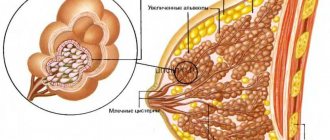The female body faces changes every month. Hormonal levels change, which often affects the condition of the fair sex and the occurrence of certain problems and deviations from the norm. One of the disorders in the reproductive system is bleeding between periods, heavy and not very heavy. Many women face such unpleasant situations. However, few of them know that this is not always dangerous. Therefore, before you start to panic and run to the gynecologist, it is better to understand and find out what caused the blood.
Discharge in the middle of the cycle often causes anxiety
Can spotting between periods, in the middle of the menstrual cycle, be normal?
Women are often faced with what appears at first glance to be a problem such as spotting between periods, when clots of brown blood appear in the middle of the menstrual cycle. Normal reasons, that is, those that are not the result of health problems, include the following causes of discharge between periods (menstruation). This is the onset of pregnancy, due to which the embryo is fixed in the area of the woman’s uterine wall, where many capillaries are located. As a result of this process, bleeding may occur between periods. Other causes of spotting between periods, intermenstrual bleeding, is the use of hormonal contraception, such as a hormonal IUD (intrauterine device).
Also, brown discharge between periods can be a consequence of using hormonal birth control pills. Especially in this case, vaginal discharge appears before and between menstruation, when a woman is just beginning to get used to hormonal OCs, that is, she uses them for no more than 3 or 4 months.
And if spotting appeared a week before menstruation, then in this case the article may be useful to read: dangerous causes of spotting before menstruation, what kind of spotting before menstruation can be considered normal.
The causes of brown, scanty or heavy vaginal discharge between menstruation include minor damage to the vagina and symptoms of the beginning or end of the menstrual process.
Normal brown discharge
It is considered normal if a woman experiences lightly colored, scanty (spotting) brown-brown discharge immediately before or immediately after her period.
In the middle of the cycle, brown discharge is considered natural if it is insignificant and odorless. The cause may be physiological changes in the body.
Ovulation. At the moment of rupture of the follicle and the release of a mature egg, a small amount of blood may be released, which, after oxidation in air, acquires a brown tint. This usually happens on the 14th day from the start of menstruation.
Attachment of the egg to the wall of the uterus after fertilization. At the moment of implantation of the fertilized egg into the endometrium, slight damage to the endometrial vessels occurs. Drops of coagulated blood stain the secreted mucus. At this moment, a woman may even feel a slight pain in the lower abdomen.
Miscarriage in the early stages of pregnancy. If for some reason (due to the presence of scars, adhesions) the egg peels off from the endometrium, then slight bleeding occurs. The discharge turns reddish-brown, lasts 1-2 days, and then returns to its normal color. In this case, the woman often does not even understand that she was pregnant and had a miscarriage.
Puberty. Girls' first periods, as a rule, come with large deviations; the cycle is established in about 1.5-2 years. Until hormonal processes are finally regulated, brownish spotting may appear between periods.
During premenopause. Menstruation during menopause also becomes irregular due to weakened ovarian function. Between menses and even instead of them, scanty bloody-brown discharge often appears.
Warning: If this symptom is present, it is important not to miss a serious illness (inflammatory process, tumor formation).
Video: Is bleeding between periods dangerous?
What diseases can occur if there is spotting between periods?
Some of the common diseases and health problems that lead to the development of symptoms such as heavy or scanty brown bleeding between periods include: endometritis (a disease in which the development of an inflammatory process in the uterus), the appearance of uterine polyps or fibroids, the development of a malignant disease (affecting the cervix), infectious diseases of the female reproductive system. The reasons for the appearance of discharge in the period between menstruation may be problems such as endometriosis (a disease in which excessive growth of the endometrium occurs), a consequence of a biopsy or burning, or a consequence of the progression of PCOS (polycystic ovary syndrome). With uterine fibroids, irregular and scanty discharge between periods is usually observed. It is important to remember that the causes of unhealthy discharge can be numerous, you should be especially suspicious of this situation if you have pink discharge instead of your period, it is very important to understand when such symptoms may indicate the development of health problems. It will also be useful to read the article: pink discharge before menstruation and learn about the reasons for its appearance.
Further in the article, the causes and symptoms indicating them in the development of such a problem as brown discharge between periods (menstruation) are discussed in more detail.
What tests and examinations can a doctor prescribe?
The doctor may prescribe both blood and smear tests, as well as X-ray and ultrasound examinations.
The smear can be examined for the presence of bacteria, to determine the type of infection, and to determine the reaction of bacteria to various antibiotics.
Examination of a smear using a microscope helps to detect epithelial cells that are subject to inflammation.
A general analysis of urine and blood will help identify the condition of the blood and possible infections.
The most common methods using medical equipment are colposcopy, ultrasound and x-ray.
The first method involves examining the desired areas using optics to identify inflammatory processes, ultrasound is done to find diseases that cannot be detected during examination or to confirm the diagnosis, x-rays can reveal various pathologies and defects of internal organs.
What is menstruation and what causes it
Menstruation is the process of removing an unfertilized egg from the body, accompanied by bleeding and the release of dark brown clots - excess cell mass rejected by the body, formed in the internal cavity of the uterus on the eve of ovulation.
The first menstruation occurs at the age of 11-13 years, and the nature of its course is largely determined by the individual characteristics of the body (weight, general health, heredity). On average, the menstrual cycle lasts 27-35 days. The presence of an established menstrual cycle indicates the absence of health problems. However, it happens that menstruation comes exactly on time, but in the middle of the menstrual cycle, spotting occurs that has nothing to do with monthly bleeding. If such discharge occurs, you should definitely consult a specialist, especially if blood is discharged from a pregnant woman - there is a risk of losing the fetus.
The appearance of bleeding between periods is often observed in adolescents during the formation of the menstrual cycle, in women who have recently given birth and in women experiencing menopause. In these cases, they are considered a type of norm.
An article about which vaginal discharge can be considered normal and which period discharge may be a sign of a problem may also be useful. Read more about this in the article: Causes of Unhealthy Vaginal Discharge. Menstruation with a bright scarlet color can also be considered dangerous and what could be the reasons for their appearance.
You should be wary if the discharge is accompanied by:
- nagging or acute pain in the genital area;
- high fever coupled with vaginal dryness;
- pain during intercourse.
If any of the above signs appear, you should immediately make an appointment with a gynecologist.
When intermenstrual secretion indicates pathological processes
Experts say that the appearance of brown bloody discharge between periods is not always caused by individual physiological processes occurring in the organs of a woman’s reproductive system. More than half of the cases of visiting a gynecologist with similar symptoms reveal the presence of pathological conditions occurring in the body of the fair sex.
This phenomenon cannot “appear” out of nowhere and “disappear” into nowhere. There are several signs that characterize the appearance of brown discharge as a symptom of a disease in the organs of the reproductive system :
- Large volume of brown mucus rejected.
- Cutting pain in the lumbar region and lower abdomen, accompanied by discharge.
- The duration of secreted mucous cinnamon clots is more than a week.
- An unpleasant odor that accompanies the rejection of a mucus-like substance.
- Irregular, scanty menstruation.
- The presence in the anamnesis, along with the rejection of brown secretion, fever, nausea and vomiting.
Causes of discharge between periods
Bloody discharge, which is a type of normal, has a dark brown tint, and its appearance does not cause discomfort in a woman.
The most common causes of discharge between periods include:
- the body’s reaction to the approach of menstruation (if discharge appears a day or two before the onset of menstruation);
- continuation of the process of rejection of intrauterine tissue (if discharge is observed no longer than a couple of days after the end of menstruation);
- taking contraceptive medications can also be one of the reasons for the appearance of scanty or heavy discharge between menstrual cycles;
- damage to the vaginal walls during sexual intercourse (for example, due to insufficient lubrication or insertion of a foreign object into the vagina);
- taking emergency contraception;
- first sexual experience (rupture of the hymen and low elasticity of the internal muscles of the vagina during the first sexual intercourse increase the risk of microcracks and rupture of small vessels, which leads to bleeding).
If an examination by a doctor shows that there are no health problems, and the woman does not experience inconvenience from unscheduled discharge, then it is considered normal.
Which doctor should I contact?
The main doctors you should contact in the absence of menstruation, or, conversely, heavy discharge, are an endocrinologist and a gynecologist. With the help of research and examination, they will be able to identify the presence of diseases such as hypothyroidism or hyperthyroidism, which affects not only the instability of the menstrual cycle, but also the ability to bear children.
If you suspect a tumor, you need to go to an oncologist who can confirm or refute such suspicions and prescribe competent therapy.
If surgery is necessary, you need to contact not only a gynecologist, but also a surgeon, transfusiologist, and anesthesiologist.
Bloody discharge in the middle of the menstrual cycle - causes
If there is at least another week or two left before the onset of menstruation, and a woman experiences bleeding from the vagina between periods, then it is worth visiting a doctor to exclude the possibility of developing diseases such as:
- endometriosis;
- cervical erosion;
- inflammation of the appendages;
- endometritis of the uterus;
- cancerous formations.
You should immediately consult a doctor if you experience spotting between periods:
- accompanied by a dull, aching pain in the genital area (an acute inflammatory process in the uterus is possible);
- appear after normal sexual intercourse using a sufficient amount of lubricant (if the situation repeats regularly, this indicates a risk of developing tumor formations);
- occur against the background of irregular monthly bleeding.
Intermenstrual bleeding is often observed in the following cases:
- taking contraceptive medications (after 3-4 months from the start of taking the medication, the cycle should be restored, otherwise you should consult a doctor);
- taking hormonal medications;
- disorders of the thyroid gland;
- inflammatory processes of the genitourinary area;
- genital injuries;
- dysfunction of the ovaries and appendages;
- severe stress, psychological trauma;
- a sharp change in climatic conditions (for example, when moving to another country located in a different climatic zone);
- infection with sexually transmitted diseases;
- excessive physical activity;
- improper installation of the intrauterine device.
Girls who have unprotected sex, as well as pregnant women, should pay special attention to the appearance of intermenstrual bleeding, since the presence of “unscheduled” discharge may indicate pregnancy (if the discharge is scanty and does not cause discomfort) or a threat of miscarriage (if the bleeding is profuse). and is accompanied by painful sensations in the genital area).
When a sign is considered a physiological norm
During the period between menstrual bleeding, a woman produces a secretion that is odorless and is a white mucus-like substance. The daily amount of such secretions ranges from 50 mg.
In the case when a woman notices that she has brown discharge after her period and it lasts for 2-3 days, this is also the norm. This fact is explained by the fact that in the last days of menstruation, blood leaves the body less intensively, and when it reaches the exit from the vagina, it has already had time to clot. Clotted blood is brown in color.
If brown or other discharge uncharacteristic of the female body appears a week after menstrual bleeding, the woman is advised to consult a gynecologist, since this symptom may indicate one of the many diseases of the reproductive system. As a rule, such vaginal discharge is additionally accompanied by an unpleasant odor, similar to the smell of rot. Such symptoms are characteristic of infectious diseases, as well as endometritis and endometriosis.
Trying to independently determine the pathology, much less treat it, is strictly prohibited. The fact is that minor bloody or brown discharge that occurs in the intermediate period between menstruation can be a symptom of pregnancy. This process is observed in many women, and it occurs during the period when the embryo is implanted into the wall of the uterus. Particular attention to this symptomatology should be paid to those representatives of the fair sex who have had unprotected sexual intercourse.
Women who take hormonal contraceptives also often experience the appearance of brown or bloody discharge in the middle of the menstrual cycle. But this phenomenon is considered normal only when the discharge appears in the first few months after the woman began using the contraceptive drug.
After installation of the intrauterine device, the volume of menstrual bleeding may increase at first. After approximately 2-3 months, the process returns to normal, provided that no additional complications arise. In addition, if earlier menstruation lasted 4 days, then after inserting the IUD into the uterine cavity, their duration can also increase, but no more than 1-2 days.
Brown or beige discharge from the genitals may occur after a gynecological examination or due to minor surgical interventions on the cervix. They are usually scanty and disappear after a couple of days.
Each stage of the cycle is characterized by its own type of secretion:
- Menstruation is bloody. It takes 3-5 days. In the first 1-2 days, the discharge is abundant, has a bright red color, and may contain clots. In recent days they are rare, smearing in nature, and have a darker color. This is due to the fact that at the end of menstruation, blood is released more slowly, and its coagulability increases.
- Ovulation: viscous, liquid, transparent, abundant. The consistency is similar to egg white. They talk about the release of an egg ready for fertilization.
- In the second half of the cycle and before menstruation: thick, creamy, white (in the absence of fertilization).
- Upon conception (on the 7th day after ovulation): at the moment of attachment of the fertilized egg, red spots in the mucus are possible.
- After sex: transparent, white or yellowish.
- During pregnancy: light or white liquid consistency.
During a normal cycle, there should be no discharge after menstruation. If they do not stop after menstruation has ended, this is not always a deviation. The body is freed from residual blood within 2-4 days. In this case, the discharge is rare and brownish. This color is obtained due to the oxidation of rejected clots. There are several reasons why the duration of menstruation increases:
- mild colds;
- emotional overload, stressful situations;
- excessive physical activity;
- sex at the end of menstruation;
- exposure to heat;
- taking medications that affect blood clotting;
- incorrect use of contraceptives.
Normal discharge after menstruation is scanty, transparent or whitish, reminiscent of jelly. On the eve of ovulation, in the middle of the menstrual cycle, the discharge is clear, more liquid, and stretchy.
In the second part of the cycle, the mucous coming out of the genital organs resembles a thick cream, intensifying every day. In the morning after unprotected intimacy, a white liquid is abundantly released from the vagina.
Brown spotting is acceptable for a couple of days after menstruation or the first months when starting to use birth control pills.
A slight addition of blood to the mucus discharge 1–2 weeks after menstruation is not considered a deviation. She ends up in a secretion due to a ruptured follicle. This is a physiological process, it does not pose any threat.
An unpleasant odor, itching or burning is not typical for normal discharge.
Dirty brown mucus in the middle of the cycle is a symptom of hormonal imbalance, abruption of the placenta or fetus at an early stage of development in pregnant women and other dangerous diseases that necessarily require treatment.
- Bleeding after menstruation or menstruation lasting more than a week are symptoms of an ectopic pregnancy.
- Greenish or yellow discharge after menstruation indicates infection, erosion or inflammation of the genital organs.
- The appearance of a white, cheesy secretion with a sharp, sour odor indicates thrush or candidiasis.
- Green or yellow-green foam is a manifestation of infection of the genital organs.
- Greenish or gray discharge after menstruation that has a fishy odor indicates vaginal dysbiosis.
- Thick green purulent mucus is a sign of purulent cervicitis.
Menstruation
Cyclic discharge lasting from three to ten days is normal and indicates the “correct” functioning of the reproductive organs. The mucus mixed with blood that is rejected during a given period of time is called menstruation. The first two or three days are characterized by the most intense and abundant discharge; towards the end, the secreted substance becomes scanty and, visually, resembles a red daub.
Often, women notice the presence of a rejected substance after the end of the “official” period of critical days. This phenomenon, according to doctors, is not a symptom of the disease. The cause of brown discharge after menstruation without an unpleasant odor and pain, in this case, is the cleansing of the uterine cavity from coagulated menstrual blood. The substance on the pad during this period may be dark brown or black.
Brown discharge
Experts say that such spotting should end within one to three days after menstruation. Based on the information received, we can conclude that this case should not give serious cause for concern and does not require medical intervention with subsequent treatment. After all, what is happening is caused solely by the rejection of blood clots that managed to coagulate before leaving the uterine cavity.
Starting to take hormonal contraceptives makes its own, acceptable, adjustments to the functioning of a woman’s reproductive system. Experts say that the presence of heavy brown discharge after menstruation for one to three months after the introduction of a new drug is a physiological norm, which can only indicate the effectiveness of contraception.
In this case, you must immediately contact a specialist to choose a different hormonal contraceptive or stop using it yourself.
Ovulation
When the egg matures and is completely ready for fertilization, dark discharge may appear in the middle of the cycle. This process is not a disruption in the functioning of the reproductive organs; on the contrary, it indicates their complete health.
But the presence of mucous clots of similar pigmentation for a long time may indicate a disease that affects the reproductive organs. In this case, you must immediately contact a specialist.
There are a number of signs that force us to consider dark spotting after menstruation in the context of the symptoms of pathological processes occurring in a woman’s reproductive organs. According to gynecologists, you should be wary if the rejection of brown mucous clots is accompanied by:
- increased body temperature;
- unpleasant musty smell.
You should also pay increased attention to the symptom under the following conditions:
- Sexual intercourse is accompanied by unpleasant, painful sensations.
- The patient does not take hormonal contraception, but after menstruation the dark brown discharge continues.
- More than a year passed from the onset of menopause before clots with blood pigment appeared.
- The described symptom is accompanied by sharp pain in the lower abdomen or groin area.
- There are sudden disruptions in the menstrual cycle.
Brownish discharge after menstruation may indicate the possible presence of inflammatory processes in the uterus, an ectopic pregnancy, or sexually transmitted diseases.
Diagnosis of the true cause of what is happening is carried out by a specialist after examination in a gynecological chair and deciphering the test results obtained from studying physiological fluids in a laboratory. Below are the diseases that most often provoke the described symptom.
Endometriosis
Omitting medical terminology, endometriosis is a sharp increase in endometrial cells outside the uterine cavity. Statistics show that most often this disease affects women under 30 years of age. Endometriosis can begin not only with heavy brown discharge that continues after the end of menstruation, but also with sudden pain in the groin area.
Endometritis
Bloody discharge before menstruation (menstruation)
As mentioned earlier, the release of a small amount of blood clots before menstruation, spotting before the onset of menstruation, is considered a type of normal and in itself is not a cause for concern. It is worth contacting a specialist if, after scanty discharge before menstruation, full menstruation does not occur, as this may be a consequence of:
- polyposis or cystosis of the uterus;
- endometriosis;
- serious hormonal disorders;
- diseases of internal organs.
Another type of normal is the release of blood clots after the end of menstruation, but with one amendment - if the period does not exceed 4 days. If the discharge does not stop for 5 days or more, you should immediately consult a specialist.
Prevention of brown secretions between periods
Experts say that there is no universal remedy for preventing the rejection of intermenstrual secretions, because the causes of this problem are different. Despite this, a number of simple rules can be identified to reduce the risk of brown mucous fluid appearing between menstruation to a minimum:
- Moderation in physical activity.
- Careful selection of contraceptives.
- Maintaining a daily routine.
- Balanced diet.
- Having a permanent sexual partner.
- Compliance with personal hygiene rules, especially during menstruation.
Doctors recommend going for a gynecological examination once every 6 months. This procedure will not help prevent brown discharge in the middle of the cycle without pain and odor, but it will allow you to diagnose possible pathological processes in time and begin comprehensive treatment.
The nature of discharge from the genital tract, even in a healthy woman, often changes. This is due to processes occurring during the phases of the cycle, hormonal changes that have physiological causes, and also those arising as a result of diseases. The color, smell and volume of discharge are indicators of normality or abnormalities in reproductive health. Thus, the appearance of light, viscous discharge in the middle of the cycle usually does not cause concern if it is not accompanied by malaise. If they have a brown tint, this can be either normal or pathological.
- Hormonal disorders
- Diseases that can cause pathology
Discharge with blood clots between periods - causes
It is important to know that if a woman has blood clots between periods, between menstruation, then you should not wait, you need to come to an appointment with a gynecologist, especially in cases where blood clots, blood clots between periods are repeated and appear frequently.
The reasons for the appearance of blood clots in the period between menstruation may be problems such as bending of the cervix (as a result of which blood cannot flow out normally, which is why it is removed from the vagina in the form of clots), peeling of the epidermis (a consequence of endometriosis), one of the signs development of gynecological disease during menopause, menopause (manifests in the form of too much bleeding from the vagina, the appearance of blood clots after sexual intercourse, disruptions in the menstrual cycle, irregular periods and other symptoms). You can read more about the reasons for the appearance of brown vaginal discharge in the article: black (brown) discharge, reasons, when it can be considered a sign of a disease.
Diagnosis of menstrual cycle disorders
In order to determine the reasons that led to menstrual irregularities, expressed in the appearance of “unscheduled” discharge, the following methods are used:
- studying the patient’s medical history (hereditary factors, previous diseases, features of the menstrual cycle, sexual contacts);
- external and internal examination of the genital organs, including the use of special devices;
- sampling;
- Ultrasound of internal organs;
- referral for examination to specialists.
Do not confuse too much discharge with uterine bleeding, because... the latter can be very dangerous to a woman's health. More information about what uterine bleeding is and the reasons that cause it is written in the article: types of uterine bleeding, why uterine bleeding is dangerous.
The sooner a complete examination of a patient with menstrual irregularities is carried out, the lower the risk of developing pathologies. In some cases, seconds count, so when intermenstrual bleeding appears, you should, without wasting time, make an appointment with your doctor to diagnose the problem and prescribe adequate treatment.
Source: womanchoise.ru
Similar articles
- Causes of yellow discharge before menstruation, treatment of yellow spotting Often a doctor can make a first assessment of a woman’s health based on the regularity of her menstrual cycle and the absence of pain. If a woman is in good health, then she should not have problems with menstruation, no...
- Discharge during menopause, causes, norm and pathology The nature of discharge during menopause A woman experiences a difficult and difficult period after menopause. During this period, hormonal changes occur throughout the body. To put it simply, the reproductive function stops - because the female sex hormone...
- Bloody discharge (brown) from the vagina during menopause - causes Is bloody discharge during menopause (menopause) normal? It is worth noting that menopause does not begin immediately. During these several years, a woman’s menstrual cycle is disrupted, periods can be more or less heavy,…
Diagnosis and treatment
Each disease is diagnosed and treated individually. So, if there are hormonal imbalances, blood is taken to check for estrogen, thyroid hormones, pituitary gland and others.
If a patient comes with a complaint of bleeding and heavy discharge, a doctor’s examination using mirrors can be used as a diagnosis, helping the gynecologist determine the presence of an inflammatory process by swelling and redness.
First, they collect anamnesis, then examine and prescribe treatment. For example, endometriosis can be recognized by the uneven surface of the uterus and corresponding complaints. To confirm the diagnosis, a pelvic ultrasound is performed.
To diagnose endometritis, a bacterioscopic examination of a smear may be required. Ultrasound and endoscopic examinations are often used as diagnostics to monitor and identify changes.
Treatment is different in all cases: it may involve treatment with radio waves, physiotherapy, sometimes the intervention of surgeons is required, in some cases diet and medications such as immunomodulators, antifungals, antibiotics, etc. are sufficient.
Malignant tumors can be removed depending on the location and severity of the disease. In the early stages, you can avoid surgery and chemotherapy and get by with medications used under the supervision of a doctor.











